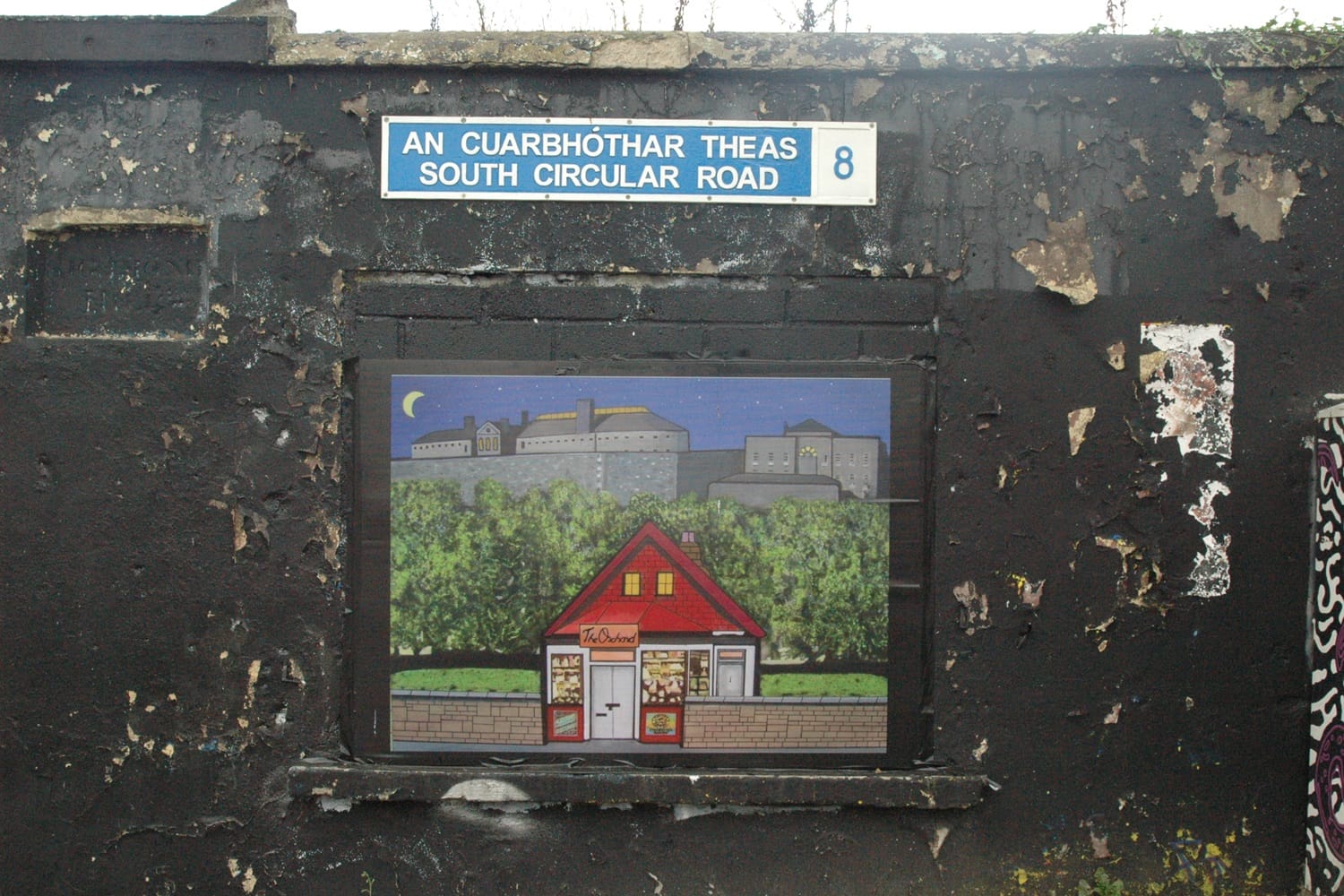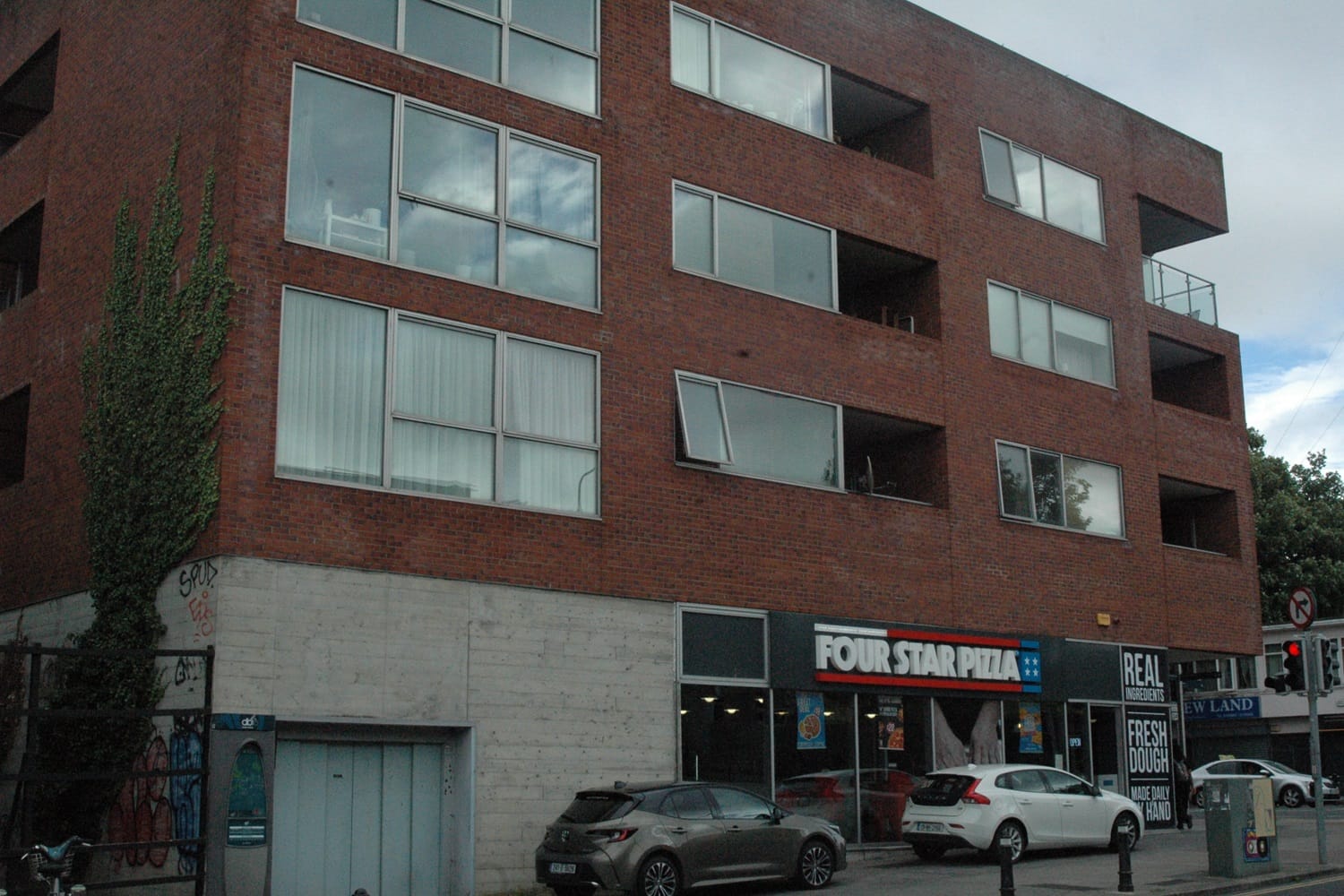What’s the best way to tell area residents about plans for a new asylum shelter nearby?
The government should tell communities directly about plans for new asylum shelters, some activists and politicians say.
To ensure the now vanished shop The Orchard is remembered, he painted it. To try to save the old library building, he ran for council.

The painting was stuck on a derelict building at the Kilmainham crossroads one day in late July.
It showed a quaint shop, with a red roof and red bricks, called The Orchard, below a starry night sky and crescent moon.
The shop’s two front windows glow, with shelves of sweets.
Below the windowsills, attached to the front of the building are a pair of posters advertising cigarettes.
Michael O’Flanagan, the local poet and activist, created it.
It was a print of his original painting, which hangs in the Glen of Aherlow pub on Emmet Road, he said over the phone in late July. “It’s a poster, like the ones you’d print for elections.”
He had stuck it over the road from 645 South Circular Road, where the old sweet shop used to be.
That was one of the local sweet shops, says Bill Brookes, who grew up just down the road.
In O’Flanagan’s painting, there is an orchard behind the shop, and Kilmainham Gaol in the distance.
Today, the corner where the shop stood is built up with a four-storey complex of apartments above and Four Star Pizza below.

Some tall trees and the complex block the old view, O’Flanagan says. “But going back into the 1880s, the Invincibles were being hanged in Kilmainham, and people used to stand in the orchard saying their rosaries.”
The Orchard was in a Victorian building, he says. “And I wanted to paint it because there’s a real nostalgia and attachment to the place.”
O’Flanagan was just fresh off the local election campaign trail when he put it up. He had run as an independent candidate for the South-West Inner City, with one priority, and one priority only: the restoration and re-opening of the Inchicore Library on Emmet Road.
But before the library, he had another cause – protecting and preserving The Orchard. His campaign lasted two decades, he says. “So I’m commemorating where the Orchard used to be.”
O’Flanagan grabbed a seat in the Insomnia café inside the Eurospar on the South Circular Road.
It wasn’t far from his home on Emmet Road
Since the pandemic lockdowns, he tries to make a habit of leaving the house for an hour or two each day, he says. “I’m over 70. For a year, I wasn’t allowed out of my home.”
The barista brought his coffee down to the table. O’Flanagan went over to the self-service counter, returning with five sachets of white sugar.
He likes to come to this spot because they play music, he says. He ripped the first sachet at one end and unloaded its contents into his cup.
“And it’s not music that I would choose. If I’m at home, I’ll listen to what I want to listen to,” he says.
He repeated the process four more times, emptying the sachets into the black coffee.
He isn’t a painter, he says. “I don’t paint. I’ve only painted six paintings.”
One of them, he believes, is hanging somewhere in the Oireachtas, he says. “I certainly didn’t think it would go there.”
His painting is a by-product of his work as a writer, he says. “I could take a year to do a painting.”
It’s not something he does to fulfil an artistic desire. It’s something he does when he is publishing a book, and needs a particular image, he says.
First and foremost, he is a poet.
O’Flanagan grew up in Walkinstown, he says.
While a pupil at Drimnagh Castle School in the 1960s he fell in love with poetry, he says. “My English teacher saw I was interested in Robert Graves after I found my dad had a book of his poetry in the house.”
He started to write poetry when he was 17, he says, although he now dismisses a lot of that as juvenile. “If it didn’t rhyme, it wasn’t a poem. That was me when I was a teenager.”
In 1970, when he was 21, he moved into his grandfather’s house in Inchicore.
Two years later, he got married, he says. “She didn’t marry me because of the house. She only married me because of my good looks.”
He cackles with delight.
Two years later, they had a pair of kids, he says. “She would get on the bus with one under each arm.”
Over the next four decades, he worked in printing, founded a publishing house, Riposte Books, and launched a poetry broadsheet, also called Riposte.
“It was a riposte to the establishment. They didn’t want to know us,” says O’Flanagan.
The Irish poetry scene was very exclusive, he says. “If you were in, you were in, but they didn’t want to know us.”
He wasn’t fussy about the quality of the poetry in the monthly broadsheet, he says. “I published everybody. I knew about quality, but I knew that wasn’t where it was at, so I’d include the high level stuff with a couple of beginners.”
His painting was a sideshow to this, O’Flanagan says. “I only paint when it’s a necessity or for a purpose.”
He wrote a biography of Henry Joy McCracken, one of the leaders of the United Irishmen, he says. “And I needed a colour image for the cover of my book.”
He painted The Orchard sweet shop because there were few decent photos of the place. And because it “had been the bane of [his] life for nearly twenty years” after he battled to prevent its demolition, he wrote in his 2018 autobiography, The Importance of Fruit.
He wanted to remind people about it, he says. “That was my motivation.”

The shop had been one of the sights that greeted people on the 123 bus bound for Marino as they passed through Kilmainham, he says.
“Or on Sundays, that was the last shop where you could get a lemonade before you went to the Phoenix Park,” he says.
All the kids would stop there with a shilling in the 60s and 70s, says Bill Brookes, who grew up on the Emmet Road. “My brothers would’ve been in there on a Friday evening for all the jars of sweets.”
They would stock fizzlesticks and bullseyes, he says. “My thing I’d get were gobstoppers.”
The Harringtons were the proprietors of the shop, O’Flanagan says. “I think they rented it.”
He couldn’t recall their first names, referring to them only as “Mr and Mrs Harrington”.
Mr Harrington died in the 1970s and Mrs Harrington ran it for a few years, before the task became too difficult, he says.
Brookes says she was like a grandmother.
“She’d be in there with the pinny, and she’d always have change in her pocket,” he says. “If I remember, she was always very polite, always had a smile for the kids.”
In the 1980s, the old sweet shop fell derelict, says O’Flanagan.
The Inchicore and Kilmainham Development Project, which he helped to co-found in 1987, took it up as a cause.
“Our group, some of them wanted it as a heritage centre, some of them wanted it as a tourist office,” he says.
Dublin City Council bought the building through a compulsory purchase order, he says. “Then I was told it was sold.”
When Carnriver Limited was granted planning permission in October 2003 to build 17 apartments and a retail unit on the land, O’Flanagan challenged it with An Bord Pleanála – and won.
An Bord Pleanála said that it could be considered overdevelopment.
Carnriver Limited applied again in April 2005, lopping off a floor and making it four storeys, and this time – despite another challenge from O’Flanagan – it was approved.
“It ended up costing me €500 after two appeals,” O’Flanagan says.
In March 2017, O’Flanagan’s painting of the Orchard shop was unveiled in the Glen of Aherlow pub on Emmet Road.
He had worked off a photo given to him by the now-deceased daughter of the Harringtons, he says. “It was a black and white photo.”
Finished with his coffee at Insomnia, O’Flanagan strolled up to the pub for a pint of cider and to visit his re-interpretation of the photo.
He took a table in the main bar, facing towards another of his works, a landscape painting of Kilmainham in the year 700 AD, with sheep grazing by a monastery and the River Camac.
It was intended to depict Kilmainham in the time of Saint Maighneann, the 7th century abbot from whom the area got its name, he says. “He was here from the 600s, and the next who came were the Vikings.”
The concept for that painting came to him in a dream, says Joe Guinan, the pub’s former owner. “Some say he fell out of the bed and hit his head, and that’s how he came up with it.”
Another one on the pub’s walls shows the ruins of Kilmainham Castle, circa 1656. The Normans built that castle in 1174, he says. “It was there for 500 years.”
The castle stood on the grounds of what is today the Royal Kilmainham Hospital, he says. “They built the hospital with some of the material from Kilmainham Castle.”
It’s a digital painting, he says, which, like with The Orchard, was done to highlight an often overlooked part of the local history. “For years, nobody had heard a thing about this castle.”
Get our latest headlines in one of them, and recommendations for things to do in Dublin in the other.